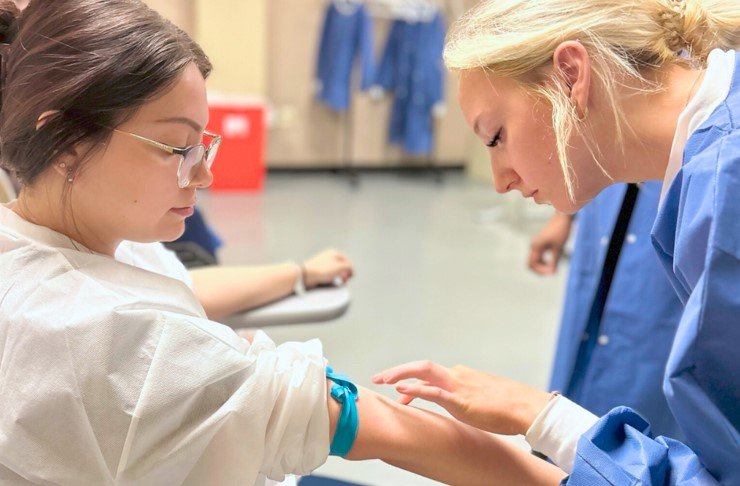Optimizing Phlebotomists' Workflows in Response to Telehealth Services: Measures and Strategies for Hospitals
Summary
- Hospitals are implementing various measures and strategies to optimize phlebotomists' workflows in response to the increasing utilization of telehealth services in the United States.
- The adoption of telehealth services has led to changes in the way phlebotomists collect and process blood samples, necessitating adjustments in hospital supply and equipment management.
- Efforts to optimize phlebotomists' workflows include the use of technology, streamlining processes, and ensuring adequate training and support for staff.
Introduction
In recent years, the healthcare landscape in the United States has been rapidly evolving, with the widespread adoption of telehealth services transforming the way patients receive care. As the use of telehealth continues to grow, hospitals are increasingly looking for ways to optimize and streamline their workflows to meet the changing demands of this new healthcare paradigm. One area that has seen particular focus is the management of hospital supplies and equipment, especially in relation to phlebotomy services. Phlebotomists play a crucial role in collecting blood samples for testing and diagnosis, and ensuring their workflows are optimized is essential for the efficient functioning of healthcare facilities.
The Impact of Telehealth on Phlebotomists' Workflows
The rise of telehealth services has had a significant impact on the way phlebotomists carry out their duties. With more patients opting for virtual consultations and remote monitoring, the need for blood samples to be collected and processed has not diminished but has shifted in terms of volume and urgency. Phlebotomists must now be prepared to collect samples from patients in a variety of settings, including their homes, as well as from traditional healthcare facilities. This shift requires hospitals to reevaluate their supply and equipment management protocols to ensure phlebotomists have the resources they need to perform their duties effectively.
Measures and Strategies for Optimizing Phlebotomists' Workflows
In response to the changing demands brought about by the increasing utilization of telehealth services, hospitals are implementing a range of measures and strategies to optimize phlebotomists' workflows. These include:
-
Utilizing technology: Hospitals are investing in technology such as Mobile Phlebotomy carts, digital scheduling systems, and remote monitoring devices to streamline the collection and processing of blood samples. These tools help phlebotomists track and manage their workload more efficiently, reducing the risk of errors and delays.
-
Streamlining processes: Hospitals are reevaluating their phlebotomy protocols to ensure they are aligned with the requirements of telehealth services. This may involve changing how samples are collected, processed, and transported to ensure they reach their destination in a timely manner. By streamlining these processes, hospitals can optimize phlebotomists' workflows and improve overall efficiency.
-
Training and support: In addition to adopting new technologies and processes, hospitals are also providing ongoing training and support for phlebotomists to help them adapt to the changing healthcare landscape. This may include training on new equipment, protocols, and techniques, as well as support for managing the increased volume and complexity of their work.
Challenges and Opportunities
While the increasing utilization of telehealth services presents challenges for hospitals in managing phlebotomists' workflows, it also offers opportunities for innovation and improvement. By embracing new technologies, streamlining processes, and providing adequate training and support for staff, hospitals can optimize their supply and equipment management practices to ensure phlebotomists can effectively meet the demands of this evolving healthcare landscape.
Conclusion
In conclusion, hospitals in the United States are implementing a range of measures and strategies to optimize phlebotomists' workflows in response to the increasing utilization of telehealth services. By investing in technology, streamlining processes, and providing training and support for staff, hospitals are ensuring that phlebotomists have the resources they need to collect and process blood samples efficiently and effectively. As the healthcare landscape continues to evolve, hospitals must continue to adapt and innovate to meet the changing demands of this new era of healthcare delivery.

Disclaimer: The content provided on this blog is for informational purposes only, reflecting the personal opinions and insights of the author(s) on the topics. The information provided should not be used for diagnosing or treating a health problem or disease, and those seeking personal medical advice should consult with a licensed physician. Always seek the advice of your doctor or other qualified health provider regarding a medical condition. Never disregard professional medical advice or delay in seeking it because of something you have read on this website. If you think you may have a medical emergency, call 911 or go to the nearest emergency room immediately. No physician-patient relationship is created by this web site or its use. No contributors to this web site make any representations, express or implied, with respect to the information provided herein or to its use. While we strive to share accurate and up-to-date information, we cannot guarantee the completeness, reliability, or accuracy of the content. The blog may also include links to external websites and resources for the convenience of our readers. Please note that linking to other sites does not imply endorsement of their content, practices, or services by us. Readers should use their discretion and judgment while exploring any external links and resources mentioned on this blog.

